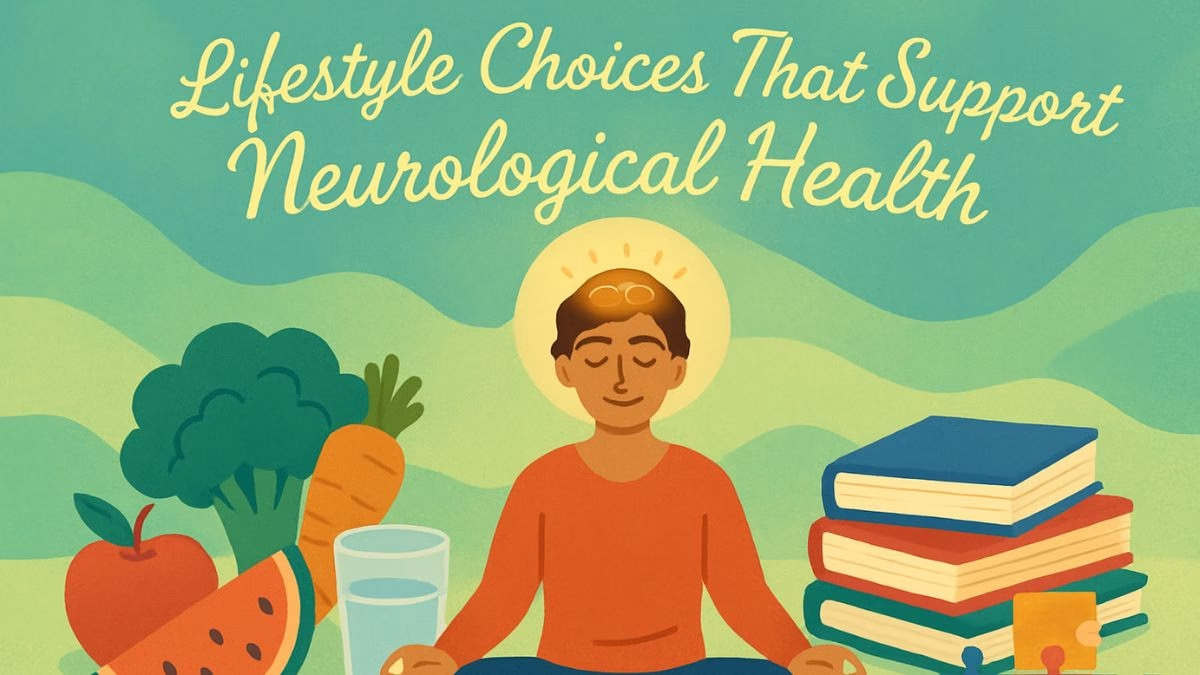- Audio Article
- 1. Feed Your Head: The Neuro-Protective Diet
- 2. The Nightly Reboot: Prioritizing Consistent Sleep
- 3. Move Your Body, Boost Your Brain
- 4. The Inner Workout: Mindfulness and Meditation
- 5. The Social Synapse: Cultivating Connection
- 6. Never Stop Learning: The Power of Novelty
- 7. Hydration: The Unsung Hero
- MagTalk Discussion
- Focus on Language
- Vocabulary Quiz
- Let’s Discuss
- Learn with AI
- Let’s Play & Learn
Audio Article
We live in an age obsessed with optimization. We hack our productivity, streamline our mornings, and bio-hack our bodies in a relentless pursuit of peak performance. Yet, in this flurry of activity, the most crucial piece of hardware we own is often treated like an afterthought. I’m talking about the three-pound universe nestled between your ears: your brain. We take its remarkable abilities for granted—the way it orchestrates a symphony of bodily functions, stores a lifetime of memories, and generates our every thought, dream, and feeling. We only tend to pay attention when it starts to falter, when the fog rolls in and the sharp edges of our intellect begin to dull.
But what if we shifted our perspective from frantic repair to dedicated maintenance? What if we understood that the daily, seemingly mundane choices we make are the most powerful tools we have for cultivating a vibrant, resilient, and long-lasting mind? The science is becoming unequivocally clear: the health of your brain is not a matter of genetic lottery alone. It is profoundly shaped by the life you lead. The food you eat, the way you move, the quality of your sleep, and the richness of your connections are not just inputs for your body; they are the fundamental building blocks of your neurological well-being.
This isn’t about a magic pill or an elusive superfood that promises to be a panacea. This is about a holistic approach, an understanding that a healthy brain is the synergistic result of a series of conscious, science-backed lifestyle choices. Forget the fads and the quick fixes. Let’s delve into the actionable, sustainable habits that can become your brain’s best friends for life.
1. Feed Your Head: The Neuro-Protective Diet
The old adage “you are what you eat” is perhaps truer for the brain than for any other part of the body. This energy-hungry organ consumes about 20% of your body’s calories and nutrients, and the quality of that fuel matters immensely. While no single diet is a silver bullet, a pattern of eating that is rich in certain nutrients has been consistently shown to support cognitive function and mitigate the risk of age-related decline.
Embrace the Fats That Fight Back: Omega-3s
If there’s one superstar nutrient for your brain, it’s omega-3 fatty acids, particularly DHA (docosahexaenoic acid). Your brain is about 60% fat, and a significant portion of that is DHA, which is a critical component of your brain cell membranes. It helps keep them flexible and fluid, allowing for efficient communication between neurons. Think of it as high-quality lubrication for your brain’s intricate machinery. A diet lacking in omega-3s can lead to stiffer cell membranes, hampering signaling and contributing to inflammation—a known antagonist of brain health.
- Actionable Advice: Make fatty fish like salmon, mackerel, herring, and sardines a regular part of your diet (aim for at least two servings a week). If you’re not a fish fan, consider a high-quality algae-based omega-3 supplement. Plant-based sources like flaxseeds, chia seeds, and walnuts are also excellent additions.
Eat the Rainbow: The Power of Antioxidants
Your brain is a metabolic powerhouse, but this high level of activity generates byproducts called free radicals. These are unstable molecules that can cause “oxidative stress,” a process akin to rust, which damages cells, including your precious neurons. The antidote? Antioxidants. These compounds, found abundantly in colorful fruits and vegetables, neutralize free radicals and protect your brain from damage. Flavonoids, a class of antioxidants found in berries, tea, and cocoa, are particularly beneficial, having been shown to improve blood flow to the brain and enhance memory.
- Actionable Advice: Don’t just eat your greens; eat your blues, reds, and purples too. A handful of blueberries in your oatmeal, a spinach salad for lunch, and some dark chocolate (in moderation!) for a treat are simple ways to flood your system with these brain-protective compounds.
2. The Nightly Reboot: Prioritizing Consistent Sleep
In our hustle-centric culture, sleep is often the first thing to be sacrificed. We treat it as a luxury, a period of unproductive downtime. Science tells us this is a catastrophic mistake. Sleep is not a passive state; it is a highly active and essential period of maintenance and repair for the brain. It’s when your brain takes out the trash, consolidates memories, and recharges for the day ahead.
During deep sleep, your brain activates its own unique sanitation system, the glymphatic system. This process clears out metabolic waste and toxins that accumulate during waking hours, including beta-amyloid plaques, the proteins infamously associated with Alzheimer’s disease. Consistently skimping on sleep is like letting the garbage pile up in your brain’s streets—it disrupts communication, impairs judgment, and over the long term, significantly increases the risk of neurodegenerative diseases.
- Actionable Advice: Aim for 7-9 hours of quality sleep per night. Create a consistent sleep schedule, even on weekends, to regulate your body’s internal clock. Develop a relaxing wind-down routine—turn off screens an hour before bed (the blue light disrupts melatonin production), read a book, take a warm bath, or listen to calming music. Make your bedroom a sanctuary for sleep: dark, quiet, and cool.
3. Move Your Body, Boost Your Brain
The idea that physical exercise is good for you is hardly revolutionary, but its profound and direct impact on the brain is still underappreciated. When you engage in physical activity, you’re not just building muscle and improving cardiovascular health; you’re providing your brain with a powerful chemical cocktail that enhances its structure and function.
Exercise increases blood flow to the brain, delivering a fresh supply of oxygen and nutrients. It also stimulates the release of a remarkable protein called Brain-Derived Neurotrophic Factor (BDNF). Dr. John Ratey, a renowned psychiatrist and author, calls BDNF “Miracle-Gro for the brain.” It acts like a fertilizer, supporting the survival of existing neurons and encouraging the growth of new ones, a process known as neurogenesis. It also strengthens synapses, the connections between neurons, which is the physical basis of learning and memory.
- Actionable Advice: You don’t need to become a marathon runner. The key is consistency. Aim for at least 150 minutes of moderate-intensity aerobic exercise (like brisk walking, swimming, or cycling) per week. Even short bursts of activity can be beneficial. Take the stairs, go for a walk on your lunch break, or have a 10-minute dance party in your living room. The best exercise for your brain is the one you’ll actually do.
4. The Inner Workout: Mindfulness and Meditation
A brain that is constantly stressed is not a brain that can thrive. Chronic stress floods your system with the hormone cortisol. While useful in short-term, “fight-or-flight” situations, sustained high levels of cortisol are toxic to the brain. Cortisol can damage and kill cells in the hippocampus, the brain’s key hub for memory and learning, and can even shrink the prefrontal cortex, impairing your ability to focus and make decisions.
Mindfulness and meditation are powerful practices for managing stress and effectively retraining your brain’s response to it. Meditation isn’t about “emptying your mind”; it’s about paying attention to the present moment without judgment. This practice has been shown to physically change the brain. Neuroimaging studies reveal that regular meditation can decrease the density of the amygdala (the brain’s fear center) and increase the density of the hippocampus and prefrontal cortex. It’s a direct, measurable way to build a calmer, more resilient brain.
- Actionable Advice: Start small. You don’t need to sit on a cushion for an hour. Begin with just five minutes a day. Use a guided meditation app (like Headspace or Calm) or simply focus on the sensation of your breath. The goal is not to stop your thoughts, but to notice them without getting carried away. It’s a workout for your attention and emotional regulation muscles.
5. The Social Synapse: Cultivating Connection
Humans are fundamentally social creatures. Our brains evolved to thrive in a community. In our increasingly isolated, screen-mediated world, we are at risk of forgetting this biological imperative. Meaningful social connection is not just a pleasant extra; it is a core pillar of neurological health.
Engaging in conversation, sharing experiences, and navigating social dynamics is a complex cognitive workout. It challenges your brain to interpret non-verbal cues, empathize, and see different perspectives. Beyond this mental stimulation, positive social interactions buffer us against stress and foster a sense of belonging, which is crucial for mental well-being. Conversely, loneliness and social isolation have been shown to be as detrimental to long-term health as smoking or obesity, significantly increasing the risk of cognitive decline and dementia.
- Actionable Advice: Prioritize quality over quantity. Nurture the relationships that leave you feeling energized and supported. Schedule regular time with friends and family. Join a club, volunteer for a cause you care about, or take a class. Even small, daily interactions—chatting with the barista at your local coffee shop or a neighbor you meet on a walk—contribute to a sense of connection and can brighten your brain’s day.
6. Never Stop Learning: The Power of Novelty
The brain thrives on challenge and novelty. The concept of neuroplasticity is the brain’s incredible ability to reorganize itself by forming new neural connections throughout life. Learning a new skill, whether it’s a language, a musical instrument, or a complex game, is one of the best ways to harness this power.
When you push yourself out of your cognitive comfort zone, you force your brain to build new pathways and strengthen existing ones. It’s the neurological equivalent of taking a new route home from work—it requires more attention and effort, but it also builds a more robust and adaptable mental map. A lifestyle of continuous learning and intellectual curiosity is a potent strategy for building “cognitive reserve,” a kind of mental scaffolding that can help protect your brain against the effects of aging and disease.
- Actionable Advice: Pick something that genuinely interests you and is challenging. Try learning a few phrases in a new language with an app like Duolingo. Watch documentaries on subjects you know nothing about. Learn to juggle, take up coding, or master a new recipe. The activity itself is less important than the process of engaging your brain in a novel and complex way.
7. Hydration: The Unsung Hero
It’s so simple we often forget it, but adequate hydration is absolutely critical for optimal brain function. Your brain is about 75% water, and even mild dehydration can have a noticeable impact on your cognitive performance. Dehydration can shrink brain tissue, impair memory, disrupt your mood, and reduce your ability to concentrate. Before you reach for that third cup of coffee to combat afternoon brain fog, ask yourself: have I had enough water today?
- Actionable Advice: Keep a water bottle with you throughout the day as a visual reminder. If you find plain water boring, infuse it with lemon, cucumber, or mint. Eat water-rich foods like fruits and vegetables. Aim for a consistent intake throughout the day to keep your brain happily hydrated and firing on all cylinders.
Your brain is the architect of your entire life experience. Tending to its health is not an act of vanity or a fleeting wellness trend; it is the most profound investment you can make in your own future. By weaving these seven habits into the fabric of your daily life, you become an active partner in your neurological well-being, building a mind that is not only sharp and clear today, but resilient and vibrant for all the years to come.
MagTalk Discussion
Focus on Language
Vocabulary and Speaking
Alright, let’s pull apart some of the language we used in that article. Words are fascinating because they’re not just labels; they’re containers for meaning and feeling. Using a precise, powerful word can elevate an idea from something you just understand to something you truly feel. Let’s start with the word panacea. In the introduction, I mentioned that this guide isn’t about a “magic pill or an elusive superfood that promises to be a panacea.” A panacea is a solution or remedy for all difficulties or diseases. It’s a cure-all. The word comes from the name of the Greek goddess of universal remedy, Panakeia. When we use it today, it’s often with a bit of skepticism. We talk about how there’s no panacea for the world’s economic problems, or how a particular diet is not the panacea for all health issues. It’s a great word to use when you want to manage expectations and say that a simple, single solution for a complex problem doesn’t exist. It signals a more realistic and nuanced perspective.
Next, let’s look at a fantastic word: synergistic. I wrote that a healthy brain is the “synergistic result of a series of conscious, science-backed lifestyle choices.” Synergy is the concept that the whole is greater than the sum of its parts. So, a synergistic result is one where different elements work together to produce an effect that is greater than what they could achieve individually. Think of it like this: diet is good, and exercise is good. But when you combine a healthy diet with regular exercise, the benefit isn’t just A + B. It’s more like A + B = C, where C is a much greater benefit. Their effects are amplified. You can talk about a synergistic partnership in business, where two companies achieve more together than they could alone. Or a synergistic effect of medications. It’s a sophisticated word that describes the magic of effective combination.
Let’s unpack the word profound. I used it several times, like when I said that lifestyle choices have a “profound” impact on the brain. Profound means very great, intense, or deep. It comes from the Latin ‘profundus,’ meaning ‘deep.’ It’s a word you use when “very” just isn’t strong enough. A profound change is a deep and fundamental one. A profound idea is one with great intellectual depth. A profound sense of sadness is a deep, intense grief. Using “profound” instead of “big” or “large” adds a layer of seriousness and importance to what you’re describing. It signals that the effect you’re talking about is not superficial; it goes right to the core.
Now for a more scientific, but increasingly common term: neuroplasticity. The article talks about this as the brain’s “incredible ability to reorganize itself.” Let’s break it down: ‘Neuro’ relates to the nerves or the nervous system, and ‘plastic’ in this context means ‘able to be molded or shaped.’ So, neuroplasticity is literally the quality of the brain being moldable. This is a revolutionary concept. For a long time, we thought the adult brain was fixed. Now we know it’s constantly changing in response to our experiences and behaviors. Every time you learn something new, you are physically changing your brain. While it’s a technical term, you can use it metaphorically to talk about the importance of being open to change and growth, because our brains are literally built for it.
Let’s look at the word mitigate. The article mentions that a healthy diet can “mitigate the risk of age-related decline.” To mitigate something means to make it less severe, serious, or painful. It’s about reducing the negative impact of something. You can take steps to mitigate the effects of climate change. A company might take action to mitigate its financial losses. It’s a formal and precise verb. You don’t eliminate the risk or the problem entirely, but you lessen its force. It’s a key concept in any discussion of prevention or risk management. So, wearing a helmet while cycling doesn’t eliminate the chance of an accident, but it does mitigate the risk of serious head injury.
Let’s talk about holistic. I mentioned taking a “holistic approach” to brain health. Holistic means dealing with or treating the whole of something or someone and not just a part. It comes from the Greek word ‘holos,’ which means ‘whole.’ A holistic doctor, for example, considers the whole person—body, mind, and spirit—not just the specific physical symptom. A holistic approach to a problem means you look at all the interconnected parts. In the context of brain health, a holistic approach means you don’t just focus on one thing, like diet. You consider how diet, sleep, exercise, and social connection all work together as a complete system to influence your well-being. It’s about seeing the big picture.
Let’s consider the word sedentary. This wasn’t in the final article, but it’s the perfect counterpoint to the section on exercise. A sedentary lifestyle is one that involves a lot of sitting and very little physical activity. The word comes from the Latin ‘sedere,’ ‘to sit.’ You might talk about a sedentary job, like being a long-haul truck driver, or the health risks of a sedentary lifestyle. It’s a more clinical and specific term than just “lazy” or “inactive.” It describes a pattern of behavior that has become increasingly common in our modern world, and understanding this word is key to discussing public health.
Now for a lovely, almost poetic word: elixir. This also wasn’t used directly, but it fits the theme beautifully. An elixir is a magical or medicinal potion. In old stories, an alchemist might search for the “elixir of life,” a potion that would grant immortality. Today, we use it more metaphorically to describe something that seems to have a wonderfully beneficial or restorative effect. You might jokingly call your morning coffee your “life-giving elixir.” In a more serious sense, you could say that for a stressed-out mind, a walk in nature can be a powerful elixir. It’s a word that adds a touch of magic and wonder to the thing it’s describing.
Another important word is cognitive. I talked about “cognitive function” and “cognitive reserve.” Cognitive relates to cognition—the mental action or process of acquiring knowledge and understanding through thought, experience, and the senses. It’s a broad term that covers all the high-level functions of your brain: thinking, memory, judgment, problem-solving, and attention. So, when we talk about cognitive decline, we’re talking about the weakening of these abilities. A cognitive task is one that requires mental effort. It’s a more precise word than just “mental” and is central to any discussion about the brain.
Finally, let’s look at resilience. The article talks about building a “calmer, more resilient brain.” Resilience is the capacity to recover quickly from difficulties; it’s toughness. A resilient material can be bent or stretched and then spring back to its original shape. A resilient person can face adversity, stress, or trauma and bounce back. A resilient brain, then, is one that can withstand the challenges of stress, aging, and disease without suffering permanent damage. It has a strong “cognitive reserve.” Building resilience—whether emotional, mental, or physical—is about developing the strength and flexibility to weather life’s storms.
Now, let’s pivot to our speaking lesson. Today’s topic is the art of summarizing and restating. This is a crucial communication skill in every area of life. When you can accurately summarize what someone else has said, it shows you were truly listening, and it allows you to clarify your understanding before you respond. It’s a powerful tool for avoiding misunderstandings. The basic structure is to use phrases like, “So, if I’m understanding you correctly…” or “What I’m hearing is…” or “So, in other words, you’re saying…”
Let’s practice. Imagine a friend is venting to you. They say, “I’m so overwhelmed. I’m trying to eat better and exercise, but I’m not sleeping well, and I feel like I’m failing at everything. Nothing seems to be working.”
A common response is to jump in with advice: “You should try this! Have you thought about that?” But a much more effective first step is to summarize and validate. You could say: “Wow, that sounds incredibly tough. So, if I’m hearing you right, you’re putting in a lot of effort to build healthier habits, but your lack of sleep is making it feel like you can’t make any progress, which is really frustrating.”
What have you done here? You’ve shown you listened. You’ve summarized their core problem. And you’ve validated their feeling (“frustrating”). You’ve created a space where they feel heard. You can even weave in our vocabulary. “So, you’re trying to take a more holistic approach to your health, but it feels like there’s no synergistic benefit because the sleep problem is undermining everything else.”
Here is your speaking challenge for the week. In one conversation, either at work or in your personal life, I want you to consciously practice this. When someone is explaining something complex or sharing a problem, before you give your opinion or advice, I want you to stop and use one of those summary phrases. “So, let me see if I’ve got this straight…” or “In other words…” Your goal is simply to restate their point in your own words and get a “yes, that’s exactly right” from them. It feels simple, but it’s a game-changer for connection and clarity. Try it out.
Grammar and Writing
Let’s transition from the world of speaking and listening to the craft of writing. Effective writing, especially writing that aims to persuade or inform, needs to be more than just a collection of facts. It needs structure, rhythm, and a clear voice. To help you achieve that, we have a writing challenge for you.
The Writing Challenge:
Write a short, persuasive blog post (around 500-700 words) advocating for one—and only one—of the lifestyle choices mentioned in the main article. Choose the one you feel most passionate about (e.g., sleep, exercise, social connection, etc.). Your goal is to convince a skeptical or unmotivated reader that this single change can have a profound impact on their life and brain health. Don’t just list facts; make a compelling, emotional, and logical case. Imagine you are trying to inspire a close friend to take this step.
To make your writing truly persuasive, we’re going to focus on two powerful grammatical tools: Modal Verbs for Recommendation and Parallel Structure for Rhythm and Emphasis.
Grammar Deep Dive: The Nuance of Modal Verbs
Modal verbs are those helpful little words that come before a main verb to express things like ability, permission, possibility, and necessity. Words like can, could, may, might, should, must, will, would. In persuasive writing, your choice of modal verb is critical because it controls the tone and strength of your recommendation.
Let’s look at a spectrum from gentle suggestion to strong command:
- Gentle Suggestion (Possibility):could, might, may
- Example: “You could try adding a 10-minute walk to your daily routine.”
- Tone: This is very soft and non-threatening. It suggests an option without applying any pressure. It’s great for an opening paragraph where you’re trying to gently invite the reader in. “If you often feel foggy in the afternoon, you might find that a short walk is a surprising elixir.”
- Firm Recommendation (Advice):should, ought to
- Example: “You should aim for 7-9 hours of sleep each night.”
- Tone: This is the classic language of advice. It’s direct and clear. “Should” implies that this is the best course of action based on evidence. It’s the workhorse of persuasive writing. You’re not just suggesting it’s possible; you’re stating that it’s advisable. “To mitigate the long-term risks of cognitive decline, you should make sleep a priority.”
- Strong Urgency (Necessity):must, have to
- Example: “If you want to protect your brain, you must stop seeing sleep as a luxury.”
- Tone: This is powerful and emphatic. Use it sparingly for your most important points to create maximum impact. Overusing “must” can make you sound preachy or demanding, but using it at a key moment can really drive a point home. It implies that the action is not just advisable, but essential.
How to Use Them in Your Challenge:
Vary your modal verbs to create a dynamic and persuasive voice.
- Start gently with could and might to introduce the problem and possibility of a solution.
- Use should for your main, evidence-backed recommendations.
- Save must for your concluding thought or your most critical piece of advice to leave a lasting impression on your reader.
Writing Technique: The Power of Parallel Structure
Parallel structure (or parallelism) is the repetition of a chosen grammatical form within a sentence. It’s about creating balance and rhythm. In its simplest form, it means if you start a list with a verb ending in “-ing,” you should continue with verbs ending in “-ing.”
- Not Parallel: “I love hiking, to swim, and ride my bike.” (The verb forms are inconsistent.)
- Parallel: “I love hiking, swimming, and riding my bike.” (The “-ing” form is repeated, creating a smooth and satisfying rhythm.)
But parallelism can be much more sophisticated. You can repeat prepositional phrases, clauses, and entire sentence structures to create emphasis and make your ideas more memorable.
Look at how it works in persuasive writing:
- For Listing Benefits:
- Without Parallelism: “Better sleep helps you to have more focus, and your memory will improve, and you are also in a better mood.” (Clunky and disjointed.)
- With Parallelism: “Better sleep helps you sharpen your focus, consolidate your memories, and elevate your mood.” (The repetition of the simple verb form creates a powerful, punchy list.)
- For Creating a Powerful Contrast:
- Without Parallelism: “We treat our phones with care, but our brains are often neglected.”
- With Parallelism: “We spend our days charging our phones, but we forget to charge our brains. We protect our screens with cases, but we fail to protect our minds with connection.” (Repeating the “We… but we…” structure creates a powerful contrast and makes the point more dramatic and memorable.)
- To Build an Argument:
- “It is the habit that costs nothing but gives you everything. It is the practice that demands little but delivers profoundly. It is the choice that seems small but ripples through your entire life.” (Here, the entire “It is the… that… but…” structure is repeated, building the argument step by step and creating a powerful rhetorical effect.)
How to Use It in Your Challenge:
- When you list the benefits of your chosen lifestyle habit, use parallel structure to make that list clear and impactful.
- Try to create at least one powerful contrast using parallelism to highlight the absurdity of neglecting this core need.
- When you’re making your final, impassioned plea to the reader, use parallelism to build your argument and create a memorable, rhythmic conclusion.
By combining the strategic use of modal verbs with the elegant rhythm of parallel structure, your blog post will transform from a simple list of suggestions into a truly persuasive piece of writing that can inspire real change.
Vocabulary Quiz
Let’s Discuss
The Intention-Action Gap: Most people know that exercise, good sleep, and a healthy diet are good for them. Yet, many struggle to implement these habits consistently. What do you think are the biggest barriers standing between knowing what’s good for our brain health and actually doing it?
Consider modern work culture (long hours, sedentary jobs), environmental factors (access to healthy food, safe places to exercise), and psychological hurdles (stress, motivation, feeling overwhelmed). Is the problem individual willpower, or is it a systemic issue?
Technology: Brain’s Friend or Foe? The article mentions meditation apps and online learning tools as positives. However, technology is also a major source of distraction, blue light that disrupts sleep, and social isolation. Is technology, on balance, a net positive or a net negative for our neurological health?
Debate the pros and cons. How can we use technology more mindfully to support our brains rather than letting it hijack our attention? Share personal strategies you use to manage your relationship with your devices. What responsibility do tech companies have in designing products that are less addictive and more conducive to well-being?
The “Cognitive Reserve” Bank Account: The idea of building “cognitive reserve” is like investing in a retirement account for your brain. What are some less obvious or unconventional ways people can “invest” in their cognitive reserve beyond the main points in the article?
Think about hobbies and activities that challenge the brain in unique ways. Could things like travel, engaging in creative arts (painting, music), navigating complex social situations, or even playing certain types of video games contribute? Discuss how variety and lifelong learning are key to a diversified “mental portfolio.”
The Social Imperative: If social isolation is as dangerous as smoking, should we treat it as a public health crisis? What role should communities, governments, and urban planners play in fostering social connection?
Brainstorm concrete ideas. Could this include designing more walkable cities with public squares, funding community centers and clubs, or creating programs to combat loneliness in the elderly? How has the shift to remote work affected our social fabric, and what can be done to mitigate the isolation it can cause?
Personalization vs. Panacea: The article gives general, science-backed advice. However, everyone’s body, brain, and circumstances are different. How can individuals learn to listen to their own bio-feedback to personalize this advice and figure out what truly works for them?
Talk about the balance between following expert advice and self-experimentation. How can someone tell the difference between a helpful adaptation (e.g., finding the specific type of exercise they enjoy) and an unhelpful excuse (e.g., deciding they “don’t need” 7 hours of sleep)? What is the role of mindfulness and self-awareness in creating a truly sustainable, personalized brain health plan?
Learn with AI
Disclaimer:
Because we believe in the importance of using AI and all other technological advances in our learning journey, we have decided to add a section called Learn with AI to add yet another perspective to our learning and see if we can learn a thing or two from AI. We mainly use Open AI, but sometimes we try other models as well. We asked AI to read what we said so far about this topic and tell us, as an expert, about other things or perspectives we might have missed and this is what we got in response.
Hello. It’s great to have a moment to expand on this topic. The article provides an excellent and actionable framework covering the “big rocks” of brain health. As an AI, I can scan and synthesize a vast range of intersecting research to highlight a few crucial, often-underestimated factors that have a powerful impact on our neurological well-being.
First, let’s talk about the gut-brain axis. This might sound strange, but one of the most exciting frontiers in neuroscience isn’t in the head; it’s in the gut. Your gastrointestinal tract is home to trillions of microbes, collectively known as your gut microbiome. This ecosystem is in constant communication with your brain via a complex network of nerves, hormones, and immune pathways. An unhealthy gut microbiome—one that’s out of balance due to a poor diet, stress, or antibiotics—can send inflammatory signals to the brain, contributing to brain fog, anxiety, and depression. Conversely, a healthy, diverse microbiome, nurtured by a diet rich in fiber and fermented foods (like yogurt, kefir, and kimchi), produces beneficial compounds that can reduce inflammation and even influence the production of neurotransmitters like serotonin, about 90% of which is made in your gut. So, when you’re eating for brain health, you’re not just feeding your brain cells; you’re feeding the trillions of tiny allies in your gut that act as a first line of defense for your neurological health.
Second, I want to emphasize the profound impact of chronic, unmanaged stress. The article rightfully points out the damaging effects of cortisol. But it’s important to understand how this plays out. Chronic stress fundamentally changes your brain’s priorities. It shifts energy and resources away from the prefrontal cortex—the thoughtful, planning, “CEO” part of your brain—and redirects them to the amygdala, the more primitive, reactive, “threat-detector” part. Over time, this makes you neurologically wired for anxiety and reaction rather than calm, considered action. It literally weakens the connections in the parts of your brain responsible for higher-order thinking and strengthens the connections in the fear center. This is why practices like mindfulness aren’t just about feeling calm in the moment; they are a long-term strategy for reversing this stress-induced rewiring and restoring balance to your neural architecture.
Finally, let’s look beyond just preventing decline and talk about actively enhancing cognitive function. The article mentions novelty, which is key. But I want to be more specific: the act of effortful learning is a neurological superpower. This isn’t about passively consuming information. It’s about struggling with a new concept, a new language, or a new motor skill. When you engage in this kind of deep, focused effort, you trigger a cascade of neurochemical processes that optimize your brain for learning. It’s the struggle itself—the making of mistakes and subsequent correction—that signals to your brain, “This is important! Build a new, more efficient pathway here!” This is why learning a musical instrument or becoming fluent in a new language is considered one of the most powerful things you can do for your brain. It combines cognitive, sensory, and motor challenges, building a dense, interconnected, and highly resilient neural network.
So, as you build your brain health plan, remember these three elements: nurture your gut, actively manage your stress response, and never, ever stop engaging in the beautiful struggle of learning.










0 Comments